#Diodorus Siculus
Explore tagged Tumblr posts
Text
I get that ppl want to make sympathetic portrayals of monsters but I don’t like it when they make them squeaky clean and pure and having done nothing wrong, like for example portraying the Minotaur as never having eaten Athenian youths, when it’s a lot more interesting that he did eat them but only bc he had no other option bc he was isolated in the labyrinth and robbed of his humanity, he is treated as a bloodthirsty monster and so grew up to be a bloodthirsty monster. I also don’t like how Theseus is demonized for this specific myth when it’s one of the few heroic and selfless things he’s actually done.
Or Medusa, sure we don’t technically get any specific stories about her turning innocent people to stone and it can be argued that the statues around her cave were warriors who came to kill her and she turned them in self defense, however, according to a rationalization by Diodorus Siculus she was a warmongering warrior queen and while this is a rationalization he likely took this from a story were she actually does attack someone, and not in self defense. It also doesn’t help that sympathetic portrayals always depict her as beautiful and/or sexualized, it really says something that male/male coded monsters are allowed to stay ugly and monstrous but their female counterparts don’t get that luxury.
The reason why Shrek is so compelling is bc he gets to be a flawed character, sure he’s defending himself from villagers that attack him but sometimes he’s the one who attacks and steals from them unprovoked, not to mention he was a jerk to Donkey and Fiona, but then he grew and changed as a person.
#greek mythology#ancient greek mythology#greek pantheon#greek monsters#monsters#monster#Medusa#the minotaur#minotaur#medusa retelling#Diodorus Siculus#shrek franchise#shrek#shrek is love#shrek is life#shrek x fiona#fiona shrek#gorgon#Gorgons#archaic Medusa
118 notes
·
View notes
Text
"And at this period in the eastern parts of the island there sprung up the Giants, as they were called; and at the time when Zeus is said to have subdued the Titans, he became enamoured of one of the nymphs, Himalia by name, and begat by her three sons, Spartaeus, Cronius, and Cytus." (Diodoros of Sicily, Library of History 5.55.5)
I love when ancient authors are like "Am I talking about the Titanomachy or the Gigantomachy right now? Who tf cares!" They were certainly less concerned about this stuff than we are. Also cudos to Zeus for managing to conquer his adversaries and to get laid in the same instance. Who can multitask like him?
21 notes
·
View notes
Note
Helloo I hope you're doing well :) I was reading about Hector and realised I've never seen him outside of the Iliad. Does he appear in other texts ?
Hello and thank you very much for your sweet words and your ask! Oh yes of course. Hector appears in a plethora of ancient Greek and Roman texts but the real test is to see him outside the context of the Trojan war! Hahaha!
For example Hector appears in plenty of texts by Apollodorous in various contexts and he even mentions how Hector was the one to kill Protesilaus and that is mentioned in several sources more I believe Hyginus included as well as a writer called Philostratus mentions the death of Protesilaus by the hands of Hector. Pausanias mentions Hector in one painting or image sitting in a mourning manner next to the Ethipian king Memnon after the Thracian Thamyris. Plutarch also mentions Hector in various of his texts in the context of Trojan War. Eurypedes mentions Hector in many of his tragedies. Strabo makes mentions to Hector during his geographical expeditions. Plato mentions Hector a lot in his work (even in Apology), Pindar as well as Diodorus Siculus. Last but not least we have Aristotle who mentions Hector in various of his works.
For other roman sources we have of course the Aenead by Virgil and Ovid. Even Pliny the Elder makes mentions to Hector and of course P. Virgilius Maro as he makes commentary on Virgils' Aenead. P. Ovidius Naso also mentions him in his work among other written roman sources including Horace
For his physical description we again have the classic cases of Malalas and Dares the Phrygian. And of course again we have kinda contradictory accounts on him:
Dares the Phrygian: Hector spoke with a slight lisp. His complexion was fair, his hair curly. His eyes would blink attractively. His movements were swift. His face, with its beard, was noble. He was handsome, fierce, and high-spirited, merciful to the citizens, and deserving of love. Malalas: dark-skinned, tall, very stoutly built, strong, good nose, wooly-haired, good beard, squinting, speech defect, noble, fearsome warrior, deep-voiced.
To name a few writers who mention him! Happy to provide the passages you want in the future. Most of the contexts in which Hector is being mentioned is around the trojan war and the epic cycle or used as an example for rethorics. ^_^
And of course do not forget how Hector's name is being mentioned to Linear B tablets! ;)
I hope this helps!
#katerinaaqu answers#hector#tagamemnon#greek mythology#ancient sources#hector's name#hector of troy#heroes of the trojan war#homer#aristotle#apollodorus#pausanias#eurypedes#malalas#dares the phrygian#ovid#virgil#strabo#plato#pliny the elder#pindar#diodorus siculus
22 notes
·
View notes
Note
In your opinion, what is the most underrated source for Alexander's reign?
This is super easy. Diodoros, Book 17. Because he's part of the so-called "vulgate" and shorter than either Arrian or Curtius, and he can abbreviate events to the point they're not clear, he's sometimes discounted.
Yet he's not only our chief source for both Philip's reign (book 16) and that of the early Successors after Alexander (books 18-20), he records things not found in the others (like the alternative version of the battle of Granikos and several events in India that were not found in Kleitarchos, which he shares with Curtius [and Justin]). He also gives events going on in the same year in OTHER places. This helps us time things better such as Agis's Revolt. He can get dates wrong, but it was his dating that I used when writing Dancing with the Lion. He may be briefer (after all, he's writing a World History, not a specifically Alexander history), but he's not a bad historian. After reading back through books 16-18 a couple summers ago (didn't need 19-20), I decided I actually quite like his straightforward style.
So I think Diodoros is our most underrated source. I just wish we had 1) the missing pieces (several lacunae, especially over events I'd like to know more about), and 2) a commentary. Although I understand Frances Pownall is planning to work on one, bless her! She's a top tier scholar and her work on Brill's New Jacoby is stellar.
We now have this new, quite good (and cheaper) translation by Robin Waterfield to replace the not-as-good Welles' Loeb translation.
#asks#alexander the great#historians of alexander the great#sources on alexander the great#classics#diodoros#diodorus of sicily#diodorus siculus
13 notes
·
View notes
Text
Diodorus Siculus spent much of his life describing major historical events such as the fall of Troy or the rise of Alexander the Great. But, sometime in the middle of the first century BC, the Sicilian-born Greek writer felt moved to address a contemporary issue that had captured his attention: the drinking habits of the Gauls, the Celtic people who occupied modern-day France at this time.
The Gauls were, he observed, excessively fond of wine, so much so that they usually drank it neat and often went into battle inebriated. In Siculus’s eyes, this love of the grape not only betrayed the Gauls’ lack of breeding (a civilised Roman would always dilute his wine), it also left them open to exploitation by canny Roman traders.
“Many Italian merchants, with their usual passion for money, look on the Gallic craving for wine as their treasure,” he wrote. “They transport the wine by boat on the navigable rivers and by wagon through the plains, and receive in return for it an incredibly high price.” Then, with thinly veiled incredulity, Siculus added: “For an amphora [a wheel-thrown terracotta container that typically held around 20 litres of liquid] of wine they get in return a slave – a servant in exchange for a drink!”
It will come as a shock to absolutely no one to learn that human beings were every bit as likely to succumb to the temptations of drink 2,000 years ago as they are today. What many people will find more surprising about Siculus’s words, however, is the picture they paint of relations between the Romans and their Celtic neighbours – one in which the two peoples were engaging in trade, rather than hacking each other to pieces.
In the popular imagination, the Celtic-speaking people of western Europe were constantly at war with the Romans. The truth was very different. There were battles, of course, and the relationship would eventually end in bloodshed and subjugation after Julius Caesar launched his campaigns of conquest in Gaul in 58 BC. But the violence was preceded by long periods of peace and collaboration, and that collaboration benefited both parties.
Siculus clearly thought that the Gauls were being duped by wily Roman traders. After all, in Rome a Gaulish slave would fetch five or six times the price they could command at home. But Siculus was missing the point. In Gaul, slaves were available in surplus, a result of raiding between rival tribes. Once an external market developed for slaves, raiding could be intensified to satisfy the demand. A Gaulish leader could then offload surplus slaves in return for Roman wine that, distributed to his followers, would greatly enhance his status. For the chief, then, it was a very good deal indeed.
The Roman merchants were also doing very nicely out of their trading links with the Gauls. By the late second century BC, the Roman economy was changing dramatically. Small farms were being bought up and merged into vast estates run for their aristocratic owners by managers commanding armies of slave workers. The easiest commodity to produce on the slave-manned farms was wine. But as the estates grew and became more reliant on grape monoculture, wine production began to outstrip Italian demand. For the estates in western Italy, the solution to the problem was simply to ship the surplus to the major ports of southern Gaul – Massalia (Marseilles) and Narbo (Narbonne) – where middlemen were ready to transport it to the Gauls. The slaves acquired in return were brought back to labour on the estates. It was a system that benefited everyone – except, of course, the slaves.
— The Celts: were they friends or foes of the Romans?
#barry cunliffe#the celts: were they friends or foes of the romans#history#classics#economics#trade#commerce#food and drink#alcohol#slavery#ancient greece#ancient rome#gaul#roman gaul#celts#diodorus siculus#julius caesar
4 notes
·
View notes
Text
Semiramis and Ninyas
According to the Greek historian, Diodorus Siculus, Semiramis was the Queen of the Assyrian Empire. He writes about her in the second book of Bibliotheca historica (c. 60-30 BC), often quoting Ctesias' Persica from circa 5th century BC, a text which is now lost.
However, all indicates that Semiramis wasn't a real person, but a legendary ruler based on the real Queen Shammuramat of Assyria, who ruled besides her husband from 824 to 811 BC and then besides her son until her death in 798 BC.
In some versions of the legend of Semiramis, she has a incestuous relationship with her son, and he later murders her.
Histories, by Herodotus
The oldest preserved mention of Semiramis comes from Herodotus's work from c. 430 BC. In Histories, Semiramis is first mentioned in Book One as a rule of Babylon, who had built notable constructions on the city. In Book Three, it's stated that one of the city's gates was named in her honor. No further details about her are given.
Bibliotheca historica, by Diodorus Siculus
Semiramis was born in Syria as the daughter of the goddess Derceto (which is another name for the Phoenician Astarte) and a human man. When Derceto gave birth, embarrassed to gave laid with a mortal, she exposed the child and then killed herself. However, doves found the child and nursed her until she was found by a shepherd, who named her Semiramis and took her in as a daughter. When Semiramis reached the age to marry, officer Onnes fell in love with her and asked for her hand.
When King Ninus laid siege of Bactra, Onnes, who was the King's general, began to miss his wife, and so invited her to the battlefield. When she arrived, she notice some flaws in Bactra's defence and, along with some soldiers, managed to sneak in and capture the city.
Ninus became infatuated with Semiramis' beauty and brilliance and ordered Onnes surrendered Semiramis to him. Onnes refused at first, and, when threatened by the king, he killed himself. This allowed Ninus to freely marry Semiramis and make her his queen.
Ninus and Semiramis had a son named Ninyas, and shortly after this, Ninus died, leaving Semiramis as the queen. During her reign, she build many walls, bridges, temples and palaces, and made of Babylon one of the most influential and rich cities of the region. She refused to marry again, instead taking many lovers and then killing them.
On a visit to Egypt, Semiramis learned from the Oracle that Ninyas would conspire against her, causing he to disappear, from mortal realm but reach eternal fame. After being wounded in battle against India (which she was trying to conquer), Semiramis returned to capital, where Ninyas tried to take the throne from her. Instead of fighting against him, she passed him the crown and disappeared.
Nicolaus of Damascus
Nicolaus lived from c. 64 BC to somewhen after 4 AD. His works survive only in fragments and, in one of these fragments, we find an account of Semiramis' death.
Nicolaus writes that, according to Ctesias, an eunuch convinced Semiramis' sons with Onnes that, if Ninyas became king, the two of them would be killed and that the only way to prevent that would be for the duo to kill their mother and usurp the throne. However, as they plotted to push Semiramis off a cliff, a servant heard and told her. So Semiramis summoned her sons and the eunuch and dared them to strike against her in front of all of Assyrians.
The story cuts off at this point, but one can presume they didn't dare to kill her.
Narrations, by Conon
This text doesn't survive to us in it's entirety, but the gist of it's content has been preserved through one-paragraph summaries in Bibliotheca of Photius. It's dated between 36 BC and 17 AD.
According of Photius, Conan's ninth tale was about Semiramis, who Conan said to be the daughter (not wife) of Ninus and that:
"Semiramis, having slept with her son whether secretly and unaware or else knowingly, took him openly as her husband and from that, what was disgusting before, having sex with your mother, became good and legal for the Medes and Persians"
This is the oldest account I can find of Semiramis having committed incest. It's important to note that Photius wondered whether Conon had confused Semiramis with Atossa, a Persian queen that is sometimes referred as having married her brother, Cambyses II, and other times is given as the wife of Darius the Great and mother to Xerxes.
Fabulae, by Hyginus
The Fabulae by Hyginus is a collection of tales and lists written circa 1 AD. In his lists of "woman who killed their husbands", Hyginus cites Semiramis for killing Ninus, indicating that there must have been a version of the story that went this way. He also says that Semiramis killed herself in Babylon, by throwing herself into a pyre.
Moralia, by Plutarch
In Plutarch's writting (c. 1st Century) Semiramis is depicted as a concubine of one of Ninus' servants, until the king fell in love with her. She then manipulated Ninus into granting her the throne and then ordered the guards to kill him.
Historiae Philippicae, by Pompeius Trogus and Justinus
This one is a bit tricky to date, because while Historiae Philippicae was written by Pompeius Trogus circa 1st Century BC, the work has only been preserved through an summary written by Justinus in the late 2nd or early 3rd Century AD.
Pompeius' version must date from around the same time as Conan's writings, and it's interesting that, according to Justinus, Pompeius also mentions Semiramis incestuous desire for her son, however, in this version, the relationship wasn't consummated, as Ninyas kills her when he finds out she wants to sleep with him.
Also in this version, she takes the throne after Ninus' death, but does so disguised as a man, claiming to be Ninus' son (I guess no one questioned that the only son, Ninyas, was an infant when Ninus died). It was only after many "noble actions", having proven her right to rule, that she revealed herself a woman.
Chronicron, by Eusebius
In this work, written in the 4th Century, Eusebius cites the historian Cephalion, who lived in the 2th Century. According to Cephalion, Semiramis killed her own sons and then was killed by Ninyas.
The sons she killed are, presumably, the ones she had by Onnes.
Historiae Adversus Pagano, by Orosius
This massive history book from the 5th Century by Roman historian Orosius contains another variant of the Semiramis legend. In this account, she doesn't have a child with Ninus. Instead, she births a son from one of the many liaisons she had after becoming the solo queen.
This son is unnamed and it's not mentioned to have succeeded her on the throne like Ninyas usually does. In fact, nothing is said about Semiramis final days or what came after.
"She finally most shamelessly conceived a son, godlessly abandoned the child, later had incestuous relations with him, and then covered her private disgrace by a public crime. For she prescribed that between parents and children no reverence for nature in the conjugal act was to be observed, but that each should be free to do as he pleased."
Ecloga Chronographica, by George Syncellus
Writing from the 9th Century and referencing Ctesias', Syncellus says that Semiramis built many tombs, one for each of the lovers she buried alive.
De Mulieribus Claris, by Giovanni Boccaccio
Entering the Middle Ages, in this work composed between 1361–1362, Semiramis story gets even more 'sensational' additions: Boccaccio writes that, not only was Semiramis in love with her son, but she also created a chastity device, that was placed in every woman of the household, to prevent any other to have sex with Ninyas.
Boccaccio also adds that some belief that that Ninyas killed Semiramis out of jealousy of her having other lovers, or perhaps because he feared that a new child of hers could try to challenge him for the throne.
The Book of the City of Ladies, by Christine de Pizan
In The Book of the City of Ladies, from 1405, Semiramis is mentioned if have married Ninus, who died in battle after giving her one son. She then ruled over Assyria and waged war, adding new lands to her empire. She married her own son for she did not want another woman being crowned queen and because she believed only her son was worthy of being her husband.
de Pizan justifies Semiramis incestuous marriage by saying that, at the time there was no written law against it and that Semiramis wasn't a Christian and so shouldn't be judged by those morals (nice historical relativism of de Pizan's part).
References:
Archibald, Elizabeth. “Sex and Power in Thebes and Babylon: Oedipus and Semiramis in Classical and Medieval Texts.” The Journal of Medieval Latin, vol. 11, 2001, pp. 27–49.
Stronk, Jan. Semiramis’ Legacy: The History of Persia according to Diodorus of Sicily. Edinburgh University Press, 2017.
Worrall, Victoria Eileen. Representations of Semiramis from Antiquity to the Medieval Period. 2019.
#mythology review#mesopotamian mythology#mother x son#shipcest#Histories#Herodotus#Bibliotheca historica#Diodorus Siculus#Nicolaus of Damascus#Narrations#Conon#Fabulae#Hyginus#Moralia#Plutarch#Historiae Philippicae#Pompeius Trogus#Justinus#Chronicron#Eusebius#Historiae Adversus Pagano#Orosius#Ecloga Chronographica#George Syncellus#De Mulieribus Claris#Giovanni Boccaccio#The Book of the City of Ladies#Christine de Pizan#parent x child#filicest
3 notes
·
View notes
Text
Scientific research supports the accuracy of Herodotus' report on mummification
"David Counsell
Proving Herodotus and Diodorus?
Headspace analysis of ‘eau de mummy’ using gas chromatography mass spectrometry
Abstract
Historical accounts of the mummification process from Herodotus (5th century BC) and Diodorus Siculus (1st century BC) report the use of a wide range of aromatic plant materials, including many common herbs and spices. Mummified remains consistently emit a musty odour, likely derived from residues of these materials. Using a sampling technique, novel in archaeology, the constituents of this odour were analysed using GCMS. The sample utilised was from a particularly pungent mummy from the Leicester Museum collection; Bes-en-mut, a priest in the temple of Min at Akhmim c. 700 BC. The results revealed the presence of a wide range of turpenoid and other compounds derived from a range of aromatic plants, including well known herbs and spices such as Cinnamon and Rosemary. The abundance of these compounds in nature make it difficult to identify in most cases exactly which plants were actually used in the embalming of Bes-en-mut, with one exception. The identification of juniperol, which is unique to the common juniper, Juniperus communis, confirms the use of juniper oil in the mummification process. Overall the results support the accuracy of the historical reports particularly that of Herodotus, whose authenticity has often been called into question."
David Counsell "Proving Herodotus and Diodorus? Headspace analysis of ‘eau de mummy’ using gas chromatography mass spectrometry", in Mummies, magic and medicine in ancient Egypt. Multidisciplinary essays for Rosalie David (edited by Campbell Price, Roger Forshaw, Andrew Chamberlain and Paul Nicholson with Robert Morkot and Joyce Tyldesley), Manchester University Press, 2016
David Counsell qualiied in medicine at Leicester in 1982 and became a consultant cardiothoracic anaesthetist at Blackpool in 1991. From 2001 he was a consultant in Wrexham and from 2010 to 2015 Chief of Staf in Anaesthetics, Pain and Critical Care at Nuield Health, The Grosvenor Hospital. He obtained the Certiicate in Egyptology at the University of Manchester in 1996 and was awarded a PhD for his research into drug and intoxicant use in ancient Egypt. He became an Honorary Research Associate at the KNH Centre for Biomedical Egyptology at Manchester University and has lectured, published papers and made television appearances relating to opium, the blue lotus, cocaine, nicotine and the death of Tutankhamun (source: https://www.academia.edu/26057393/Mummies_Magic_and_Medicine_in_Ancient_Egypt_Multidisciplinary_Essays_for_Rosalie_David.)
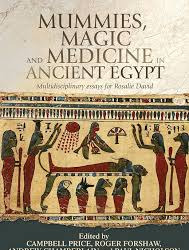
3 notes
·
View notes
Text
The Fake Texts of Ancient Greek 'Historians': the Behistun Inscription, Ctesias, Diodorus Siculus, Darius I the Great, and Semiramis
In a previous article published under the title 'Aristotle as Historical Forgery, the Western World’s Fake History & Rotten Foundations, and Prof. Jin Canrong’s Astute Comments', I wholeheartedly supported the position taken by the prominent Chinese Prof. Jin Canrong about Aristotle and I explained why Aristotle never existed as he is known today and most of his texts were not written by him, but by the pseudo-Christian Benedictine monks of Western Europe for the purpose of the ferocious imperial and theological battle that Rome carried out against New Rome-Constantinople and the Eastern Roman Empire. You can find the table of contents and a link to the publication at the end of the present article.

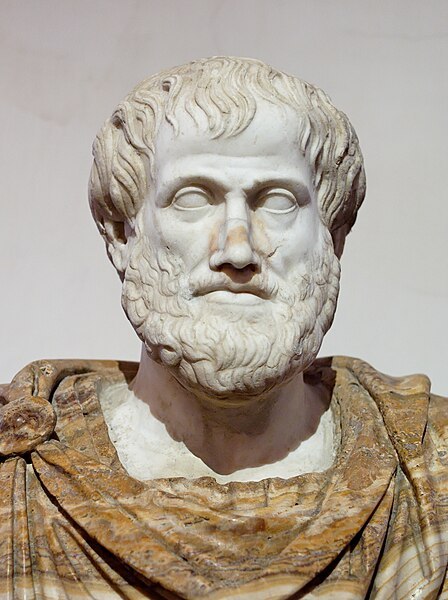
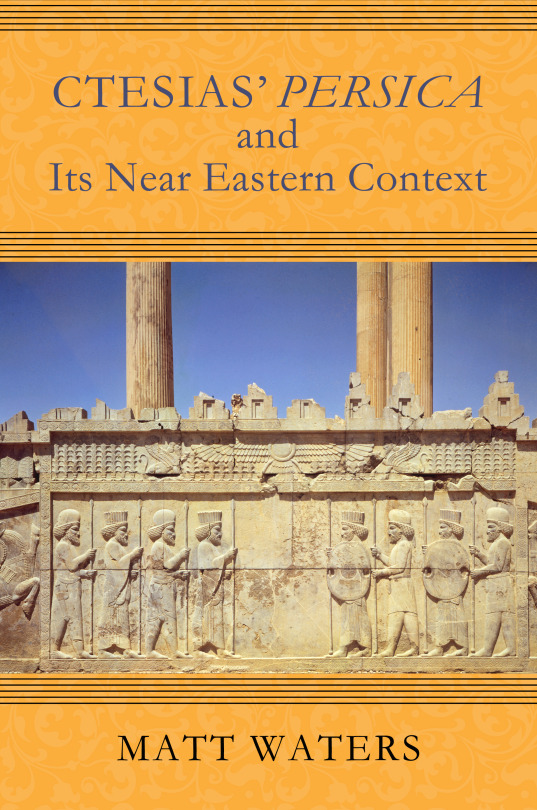
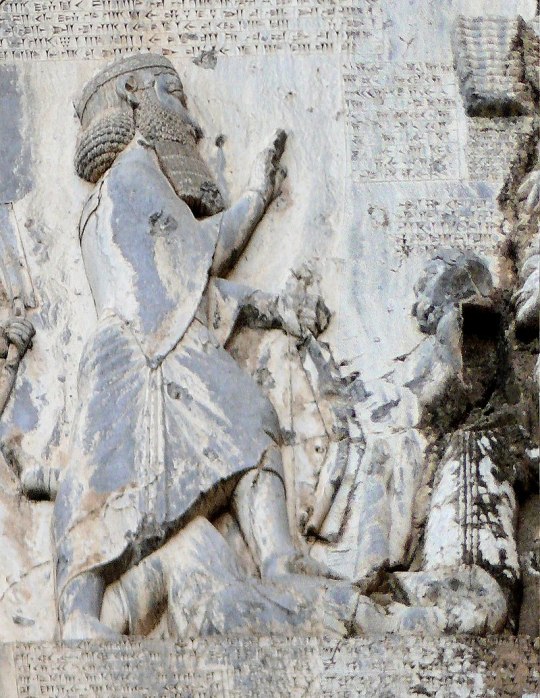
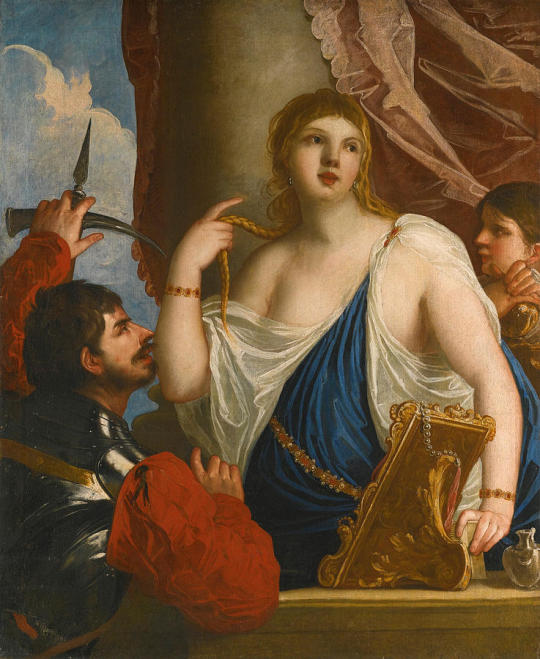
Contents
Introduction
I. A fictional concept: the origin of the fraud
II. A construct based on posterior textual sources
III. The deceitful presentation
IV. 5th century BCE texts found in 15th c. CE manuscripts do not make 'History'.
V. Abundant evidence of lies and deliberate distortions attested in the manuscript transmission
VI. Darius I the Great, the Behistun inscription, and Ctesias
VII. The historical Assyrian Queen Shammuramat and the fictional Queen Semiramis of the 'Ancient Greek sources'
VIII. The malignant intentions of the Benedictine liars: from the historical Darius I the Great to the fictional Semiramis
IX. The vicious distortions of the Benedictine liars: from Ctesias to Herodotus
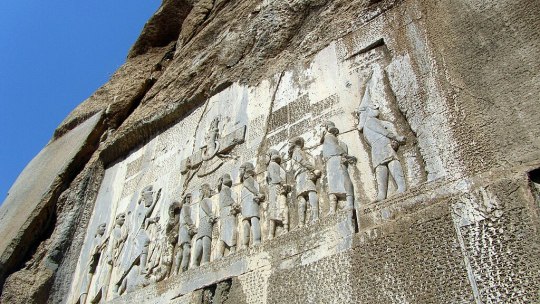
The Behistun inscription
Introduction
In the present article, I will offer a typical example of text falsification carried out by the Catholic monks, who did not 'copy and preserve' manuscripts of ancient Greek and Latin texts, as it has been mendaciously said by Western European and North American academics and lying scholars, but they purposefully falsified, distorted, concealed, destroyed and/or contrived numerous texts.
This enormous forgery took place in Western Europe between the 2nd half of the 8th century and the 1st half of the 15th century; the colonial era was launched exactly afterwards. For this reason, few manuscripts with Ancient Greek and Roman texts date before the 8th c.; in fact, most of them have been either distorted and replaced or hidden in the vast libraries still owned, controlled and administered that the anti-Christian Roman Catholic Church.
The purpose of this devious and evil effort was the fabrication of a fake narrative about the forged antiquity and the supposed importance of the Western Europeans according to the needs of world conquest, prevalence and preponderance of the pseudo-Christian Roman Catholic Church; this bogus-historical dogma, as direct opposition to and ultimate rejection of Orthodox Christianity, would be initially imposed as the 'scientific discipline of History' in Western Europe and subsequently projected onto the rest of the world by means of colonial invasion, indigenous identity destruction, moral integrity demolition, cultural heritage disintegration, educational subordination, economic exploitation, military subjugation, and socio-political domination.
In other words, the monastical scribes and copyists created an entirely fake Euro-centric past, which became the rotten foundation of Western Europe. This fallacy became known as Judeo-Christian world and Greco-Roman civilization. However, the decipherment of ancient languages (Egyptian hieroglyphic, Old Achaemenid Iranian, Assyrian-Babylonian, Sumerian, Hurrian, Hittite, Urartu, Ugaritic, etc) and the study of millions of original texts, which were not copies of earlier sources but contemporaneous to the events that they narrated, sounded the death knell of the era of history fabrication programs.
With the post-Soviet rise of the great continental powers (China, India, Russia, etc.), the economic-military-political-ideological-educational-academic-cultural tyranny of the Western World started being overthrown throughout the earlier colonized world. The historical forgery that the colonial rulers imposed collapsed, the falsehood of the Eurocentric dogma of World History started being revealed and rejected, and an overwhelming project of total de-Westernization appeared as a prerequisite for the liberation of the Mankind from the lies of the European Renaissance, the Western Humanities, the White Supremacism, the Western European colonialism and racism, as well as from the falsehood of numerous subsystems of the construct, such as Classicism, Hellenism, Orientalism, etc.
In our days, it is imperative for anti-colonial scholars to unveil the distortions applied to Ancient Greek and Latin texts by the medieval monks. Consequently, historians from all over the world have to work together in order to denounce and obliterate the Western fraud and the fake History of the Western Man, which consists in arbitrarily taking 14th c. CE manuscripts as authentic narratives of Ancient History.
I. A fictional concept: the origin of the fraud
Apparently, the present brief article cannot be an exhaustive presentation of the Western fraud, and of the historical forgery that the Western monks, manuscript copyists, collectors, academics and propagandists attempted to impose worldwide through colonial conquests, massacres and tyrannies. However, I can still enumerate the major founding myths of the Western World.
Two thematic circles of historical distortions and fraudulent claims made by the Western academia revolve around the following two entirely fabricated entities, which have conventionally but erroneously been called
a) "the Greco-Roman world" and
b) "Biblical Israel" and "Judeo-Christian civilization".
These ahistorical entities never existed. The original concept of those notions is purely fictional, and it therefore remains always unquestioned in the fraudulent Western universities. In this regard, the sources that the Western academics evoke to support their claims are posterior, untrustworthy, forged and therefore worthless.
At times, some of those texts represent merely ancient authors' misperceptions of earlier texts and authors; however, more often, the ancient texts have been tampered with. On other occasions, ancient texts that refute the lies of other historical sources are hidden from the general public and conventionally discussed among the Western academic accomplices.
II. A construct based on posterior textual sources
The entire construct hinges on the deceitful presentation of several types of material forged, collected, concealed, interpreted, contextualized, narrated, repeatedly but intentionally discussed, supposedly questioned, and selectively popularized; this was due to the fact that the said material was incessantly utilized for the colonial needs and targets of the Western European powers (England, France, Holland, Spain, Portugal, and more recently the US). In fact, the Western World's fake History was created as the ultimate support of all colonial claims.
This process happened within a system in which posterior textual sources (preserved in medieval manuscripts) have occupied the central position, whereas the ancient epigraphic material, which was contemporaneous to the historical events under study, has been deliberately disregarded.
All later discovered data and pieces of information were either adjusted to the construct or methodically hidden; this is how the original concept, pathetically believed almost as a religious dogma, remained totally unchallenged down to our days.
III. The deceitful presentation
The quintessence of the deceitful presentation involves a vicious trick; people (pupils and students, but also scholars and intellectuals, as well as the general public) are taught and made accustomed to care mainly about the absolutely insignificant dates of birth and death of historical persons (authors, rulers, etc.), and not about the dates of the manuscripts in which these individuals are mentioned as supposed authors; this situation turns readers, students and scholars into pathetic idiots.
Subsequently, we cannot seriously afford to describe Herodotus as a 5th c. BCE writer, because there is no manuscript with texts attributed to him, dating before the 10th c. CE. In addition, if we take into account the enormous number of other ancient authors decrying, denigrating and rejecting Herodotus' absurdities and malignancy, we have to permanently and irrevocably obliterate Herodotus from the History of Mankind and consider his false, paranoid and racist texts as a double Crime against the Mankind:
first, with respect to the original narrative (to which we don't have access as it was distorted by medieval monastical scribes and copyists) because the author attempted to disparage the superior Iranian civilization and the majestic Achaemenid universalist empire, while undeservedly praising the South Balkan barbarians, and
second, as regards the currently available text, which was forged as per the discriminatory intentions of the monks who altered and distorted it in their effort to fabricate the fake, modern divide (or dichotomy) East-West, and to offer a shred of historicity to it.
IV. 5th century BCE texts found in 15th c. CE manuscripts do not make 'History'.
People get therefore addicted to considering as a true and original 'work' (of an ancient author) the manuscript (or manuscripts) in which the specific treatise, essay or book was copied perhaps 10 or 15 centuries after the author composed it. Due to a long chain of intermediaries (namely library copyists, librarians, scholars, monks, collectors, purchasers and/or statesmen), the transmitted text may have been partly or totally changed.
There is absolutely no guarantee as regards the honesty, the good intentions, the unbiased attitude, and the benevolent character of the perhaps 5, 10, 20 or 50 persons who -living in different eras and without knowing one another- may have constituted the chain of (unknown to us) intermediaries between the hand of the author and that of the last copyist whose manuscript was preserved down to our times.
Example: very little matters today whether the ancient author Diodorus Siculus or Siceliotes (西西里的狄奧多羅斯) actually lived in the 1st c. BCE or in the 3rd c. CE; quite contrarily, what is important for history-writing is the fact that the earliest known manuscript of his famous 'Bibliotheca Historica' (世界史) dates back to the 10th c. CE.
Consequently, the first piece of information that should be stated after the name of any 'ancient' Anatolian, Macedonian, Thracian, Greek, Roman and other author is the date of the earliest extant manuscript of his works.
V. Abundant evidence of lies and deliberate distortions attested in the manuscript transmission
An extraordinarily high number of original sources excavated in Mesopotamia, Egypt, Anatolia, Canaan, Iran and elsewhere, and subsequently deciphered, can be dated with accuracy; example: the Annals of great Assyrian emperor Tiglath-pileser III (745-727 BCE) were written during his reign. They are contemporaneous and therefore original.
However, in striking contrast to them, almost all the manuscripts with the works of ancient Greek and Roman authors whose texts have formed the backbone of the fraudulent historical dogma of the Western academia are not contemporaneous but posterior by, at times, 1500 or 2000 years.
Even worse, numerous ancient Greek authors' texts were not preserved through a manuscript tradition at all; they were saved as references in posterior authors' works. This concerns, for instance, Ctesias (克特西亞斯), an Ancient Carian (Anatolian) physician and erudite scholar, who lived and worked in the court of the Achaemenid Iranian emperor Artaxerxes II in the 5th c. BCE.
Later, willing to offer potential guidebooks to Iran and India for the use of various peripheral peoples and tribes of the Balkan region, Ctesias elaborated in Ancient Ionian (愛奧尼亞希臘語) two treatises to describe the state of things in Iran and in India. To the Western academic bibliography, his works are known (in Latin) as 'Persica' and 'Indica'.
These texts were not saved integrally in manuscripts copied for the purpose of preserving Ctesias' works, but they were preserved in Diodorus Siculus' 'Bibliotheca Historica'. Although he is not known through authentic and contemporaneous Iranian sources, we can deduce that Ctesias certainly spoke fluently the official language of the Empire and read Old Achaemenid cuneiform. Eventually, he may have also studied and learned Babylonian and Elamite cuneiform, namely two ancient Mesopotamian cuneiform languages and writings the use of which was maintained by Iranian scribes.
Apparently, Ctesias had a firsthand insight, as he lived for many years in Parsa (Persepolis), the capital of the Achaemenid Empire and he also traveled extensively along with the Iranian emperor. But, unfortunately, the following ordeal was produced.
VI. Darius I the Great, the Behistun inscription, and Ctesias
One century before Ctesias served Artaxerxes II, the empire of Iran was saved by Darius I the Great (大流士一世; reign: 522-486), who overthrew a usurper, namely the Mithraic (密特拉教祭司) magus Gaumata (高墨达), and by so doing, preserved on the throne a dynasty of faithful Zoroastrian (瑣羅亞斯德教徒) monarchs.
To commemorate his great victory and the consolidation of the his dynasty, Darius I the Great had an enormous rock relief and a monumental inscription (貝希斯敦銘文) engraved on the rocks of Mount Behistun (貝希斯頓山), at a distance of 150 km west of Hamadan (哈马丹; Ekbatana/埃克巴坦那) in Western Iran (15 m high by 25 m wide and 100 m up the cliff). As it can be easily understood, these events occurred after the assassination of Cambyses, at the very beginning of Darius I the Great's reign.
It goes without saying that the successors of Darius I the Great and the imperial Iranian administration knew perfectly well the historical details and were fully aware of the imperial inscription that immortalized the event, which had obviously become the cornerstone of the imperial education.
VII. The historical Assyrian Queen Shammuramat and the fictional Queen Semiramis of the 'Ancient Greek sources'
However, one century later, when Ctesias lived in Iran, served the Iranian Emperor, and spoke Old Achaemenid Iranian (and if not, he was surrounded by the Empire's top interpreters and advisers), something disastrously odd 'happened'.
According to Diodorus Siculus, who explicitly stated that he extensively quoted from Ctesias' text (Bibliotheca Historica, II 13), the imperial Carian physician and author appears to have attributed the Behistun inscription and the rock reliefs to none else than the Assyrian Queen Shammuramat (薩穆-拉瑪特), who was the queen consort of the Assyrian Emperor Shamshi Adad V (沙姆什·阿達德五世; reign: 824-811) and co-regent (811-805) during the first years of reign of her son Adad Nirari III (阿达德尼拉里三世; reign: 811-783)!
Furthermore, in the 'Ancient Greek' text of Diodorus Siculus, the monumental inscription was said to be written in Assyrian cuneiform (Συρίοις γράμμασιν)! Even worse, in the same text (as preserved today), it was also stated that, in the rock relief, there was also a representation of the Assyrian queen!
Ctesias' text, as preserved by Diodorus Siculus, is truly abundant in information, but it is historically impossible and therefore entirely forged. Due to this and many other texts, an enormous chasm was unnecessarily formed between
a) the historical queen Shammuramat of Assyria, whose historicity is firmly undeniable, due to the existence of several contemporaneous cuneiform sources excavated in Assyria, and subsequently deciphered and published,
and
b) the purely fictional Assyrian queen Semiramis (沙米拉姆) of the posterior Ancient Greek textual sources that were supposedly 'preserved' (but in reality deliberately distorted and forged) in the Benedictine manuscripts of Western Europe's monasteries.
However, if we examine closely the facts, we will surely understand what truly occurred in this case; then, we will be able to fathom how the fake History of the Western world was fabricated.
The Behistun inscription is trilingual, as it was written in Old Achaemenid Iranian (the earliest form of written Iranian languages), Babylonian, and Elamite; this was a very common practice during the Achaemenid times (550-330 BCE). The main figure of the associated rock relief is Darius I the Great, evidently the representation of a male royal.
One way or another, with respect to the Behistun inscription and rock relief, Ctesias certainly knew everything that we know today after the successive decipherments of the Old Achaemenid, Babylonian and Elamite cuneiform writings, or perhaps even more, due to the then extant oral tradition.
VIII. The malignant intentions of the Benedictine liars: from the historical Darius I the Great to the fictional Semiramis
The Behistun inscription is not Assyrian; the representation is not that of female royal; and the monument is totally unrelated to Shammuramat, who had lived 300 years before Darius I the Great and 400 years before Artaxerxes II's physician Ctesias. More importantly, by that time, the Assyrian Empire did not occupy the lands surrounding Behistun. Accompanied by Iranian imperial officers and his associates, Ctesias certainly learned all the details of the monumental inscription that we can now read in articles, courses, lectures, books and encyclopedias.
The narrative was a triumph for Darius I the Great and a spectacular rebuttal of the vicious Mithraic Magi who had supported the defeated evil sorcerer and villain Gaumata. Apparently, writing a guidebook for Iran to help marginal people of the Empire's Balkan periphery, Ctesias did not have any reason to say lies. Moreover, we don't have any reason to believe that Diodorus Siculus needed to distort the truth to that extent, when copying and thus preserving Ctesias' masterpiece for the posterity.
However, the transmission of the details about the Behistun inscription embarrassed the Benedictine copyists who wanted to denigrate Darius I the Great and to portray his great empire in a most derogatory manner. They had already proceeded in this manner, distorting other manuscripts, forging texts, and fabricating their pseudo-historical narratives at will.
That is why Ctesias' pertinent text, which had certainly been preserved in its original form within Diodorus Siculus' Bibliotheca Historica, was intentionally distorted by the Benedictine 'Holy Inquisition of Libraries', which fabricated the myths of today's Western world some time after the middle of the 8th c. CE. To be accurate, Ctesias' historical description was entirely replaced by a fictional and historically nonsensical account.
The unbelievable lies -invented and included in Diodorus Siculus' quotations from Ctesias- risked making of the fictional queen Semiramis a world ruler! Whereas the Assyrian Empire at the end of the 9th c. BCE did not control even the western half of today's Iranian territory, the unequivocally mythicized Semiramis had supposedly sent her armies up to India where those fictitious Assyrian soldiers were trampled by the elephants. This worthless narrative that replaced Ctesias' original text may very well have been invented as a 'historical' excuse for Alexander the Great's failure to advance deep inside India.
IX. The vicious distortions of the Benedictine liars: from Ctesias to Herodotus
But if the fictional Semiramis' Indian campaign is entirely false, so are then the preposterous narratives of Herodotus about Darius I the Great's and Xerxes I the Great's campaigns in the insignificant and barbarian circumference of South Balkans. These texts involved evil purposes, heinous anti-Iranian biases, fictional battles, racist discourses, vicious lies, incredibly large number of the Iranian armies, and absurdly high number of Iranian casualties.
The mendacious but idiotic Benedictine monks, who wrote those slander tales did not apparently expect that, sometime in the future, excavations would bring to light splendid Iranian antiquities, original cuneiform documentation, and trustworthy contemporaneous historical sources, whereas a systematic effort of decipherment would offer to people all over the world direct access to historical texts written in dead languages, thus irrevocably canceling Herodotus' nonsensical report and, even more importantly, the later distortions that the Benedictine monks made on their worthless manuscripts.
In any case, had those fictional campaigns against 'Greece' had a shred of truth to them, they would have certainly been documented one way or another in various Old Achaemenid, Babylonian, Elamite, Imperial Aramaic, Egyptian hieroglyphic or other sources; but they were not.
Even worse, the meaningless and ludicrous battles of Marathon, Thermopylae, Salamis, and their likes would have been commemorated by the Seleucids, the Ptolemies, and the Attalids all the way down to the Romans and the Eastern Romans. But we know quite well that the nonexistent, fictional past of the so-called Ancient Greek world was absolutely irrelevant to them: precisely because it had not yet been fabricated.
===================
Aristotle as Historical Forgery, the Western World’s Fake History & Rotten Foundations, and Prof. Jin Canrong’s Astute Comments
Contents
I. Aristotle: a Major Founding Myth of the Western World
II. When, where and by whom was the Myth of Aristotle fabricated?
III. The Myth of Aristotle and its first Byproducts: Scholasticism, East-West Schism, the Crusades & the Sack of Constantinople (1204)
IV. Aristotelization: First Stage of the Westernization and the Colonization of the World
V. Aristotelization as Foundation of all the Western Forgeries: the so-called Judeo-Christian Heritage and the Fraud of Greco-Roman Civilization
VI. The Modern Western World as Disruption of History
VII. The Myth of Aristotle and the Monstrosity of Western Colonialism
======================
Download the article in PDF:
#Ctesias#Diodorus Siculus#Behistun Inscription#iran#Achaemenid#Behistun#Bisotun#Darius I the Great#Gaumata#Mithraism#Zoroastrianism#Ahura Mazda#Mithra#Xerxes I#Herodotus#Ancient Greeks#manuscript transmission#Shamshi Adad V#Adad Nirari III#Shammuramat#Semiramis#Benedictines#Renaissance#Classicism#Classics#Orientalism#Hellenism
4 notes
·
View notes
Text
There is this Egyptian tradition where Rhea is married to Ammon (not identified as Kronos) and it’s so funny to me like that’s literally and ancient crack ship. Like imagine if I shipped Hera with Sett or something.
The source is Diodorus Siculus btw
#ok but what would be a good crack ship for Hera#like which Egyptian god should it be bc I really wanna imagine her leaving Zeus for a healthier relationship#it’s not in her nature as the goddess of marriage but I want her to be happy#greek mythology#greek pantheon#ancient greek mythology#hera#greek goddess#hera goddess#hera deity#Ammon#amun#rhea titan#rhea goddess#egyptian mythology#Diodorus Siculus
22 notes
·
View notes
Text
While Heracles was making the circuit of Sicily at this time he came to the city which is now Syracuse, and on learning what the myth relates about the Rape of Corê he offered sacrifices to the goddesses on a magnificent scale, and after dedicating to her the fairest bull of his heard and casting it in the spring Cyanê he commanded the natives to sacrifice each year to Corê and to conduct at Cyanê a festive gathering and a sacrifice in splendid fashion. ...... Heracles, then, according to the myths which have come down to us, descended into the realm of Hades, and being welcomed like a brother by Persephonê brought Theseus and Peirithoüs back to the upper world after freeing them from their bonds. This he accomplished by the favour of Persephonê, and receiving the dog Cerberus in chains he carried him away to the amazement of all and exhibited him to men. - Diodoros of Sicily, Library of History 4.23.4-26.1
They are besties and Demeter likes him too: „... Demeter instituted the Lesser Mysteries in honour of Heracles, that she might purify him of the guilt he had incurred in the slaughter of the Centaurs.” - Library of History 4.14.3
14 notes
·
View notes
Text
I'm trying to include the Spartoi as Cadmus and Harmonia's surrogate sons (technically speaking they are Harmonia's nephews if you think about it...) yet I still don't have a clear idea of what these guys are supposed to look like. Therefore I've spent my time searching for how humans would've looked like if they evolved from reptiles.
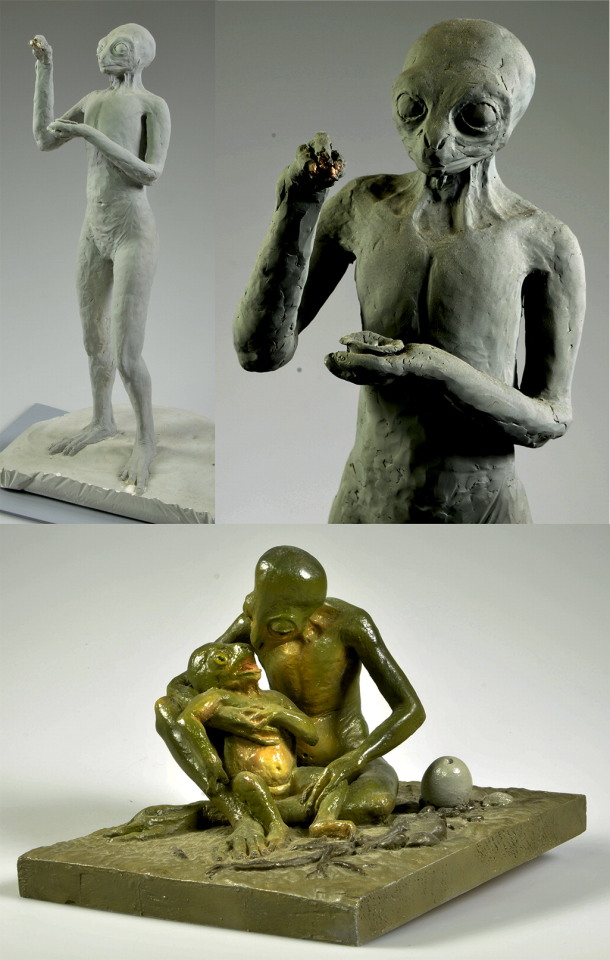
#lol don't take this seriously#but still#I remember Diodorus Siculus' account saying that Cecrops being half-snake is a metaphor for him being half-greek and half-barbarian...#Maybe I could use this idea somehow.#greek mythology#cadmus#harmonia#cadmus and harmonia#cadmonia#spartoi#ramblings
9 notes
·
View notes
Text

#Diodorus Siculus and the Successors of Alexander#alessandro magno#alessandro iii di macedonia#alexander the great#prossime uscite#alessandro il grande#alessandro il macedone#alexander the conqueror#alessandro il conquistatore#alexander iii of macedon#alexander of macedon#Edizioni dell'Orso#monica berti#Franca Landucci#Eloisa Paganoni
2 notes
·
View notes
Text
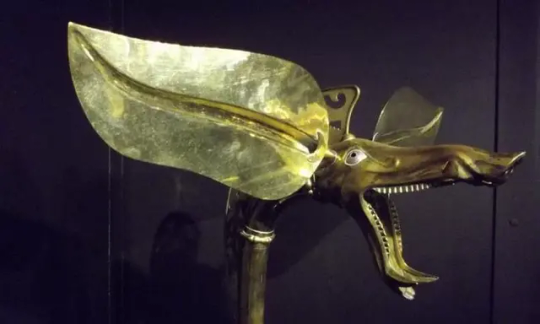

The 'Carnyx' Nightmare of the Roman Soldiers
The Carnyx was a brass musical instrument used as a psychological weapon of war by the ancient Celts between 300 BC and 200AD in western and central Europe and beyond.
The carnyx was once widespread throughout much of Europe, although only a dozen or so fragments are known to us.
It was carried by bands of Celtic mercenaries; it was present at the attack on the Greek sanctuary at Delphi in 279 BC; it defied Julius Caesar in Gaul; and it faced Claudius when he invaded Britain. They are even shown on a Buddhist sculpture in India, proof of the far-flung connections of the Iron Age world.
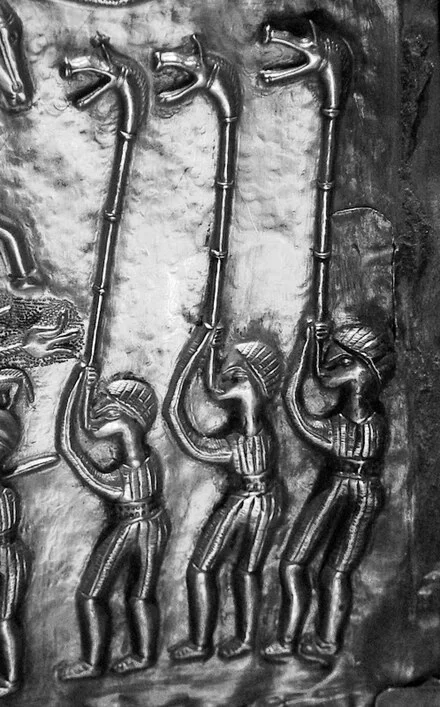
However, they were not only used by the Celts; they were also used by the Dacians in modern Romania. The term “Celtic” is a complicated one. The concept of a pan-European Celtic culture is a myth; rather, aspects of art and technology were shared across vast distances by diverse cultures. The carnyx was one example of this.
A 12-foot-long, thin bronze tube with right-angle bends on both ends made up the carnyx. The lower end ended in a mouthpiece, and the upper end flared out into a bell that was usually decorated to look like a wild boar’s had. Historians believe it had a tongue that flapped up and down, increasing the noise made by the instrument. The carnyx was played upright so that the boar’s head bell protruded well above the warriors’ heads. Its primary goal was to create more noise and confusion on the battlefield.
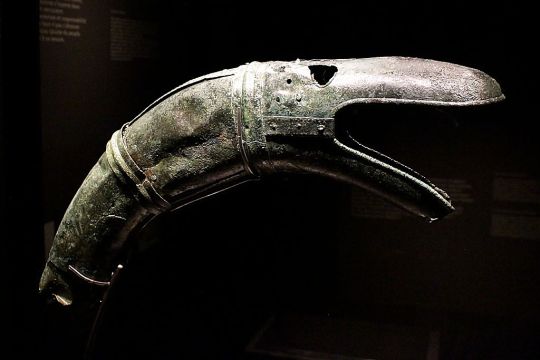
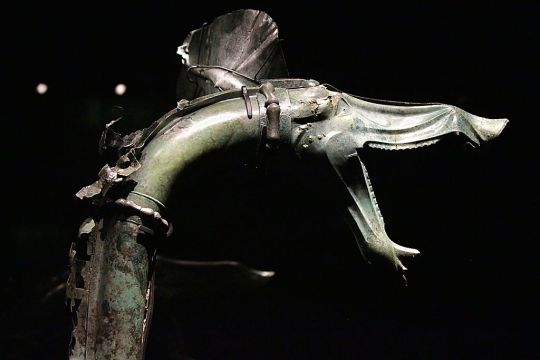
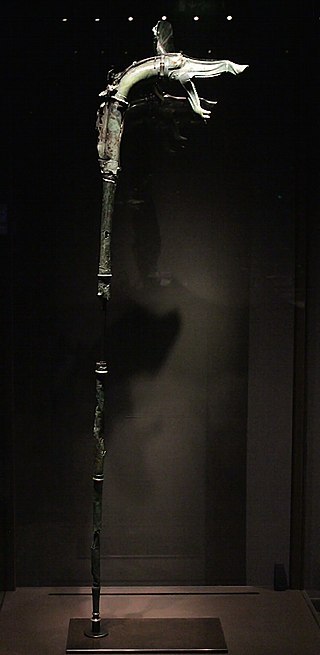
The Greek historian Polybius (206-126BC) was so impressed by the clamor of the Gallic army and the sound of the carnyx, he observed that “there were countless trumpeters and horn blowers and since the whole army was shouting its war cries at the same time there was such a confused sound that the noise seemed to come not only from the trumpeters and the soldiers but also from the countryside which was joining in the echo”.
And the Roman historian Diodorus Siculus wrote, “Their trumpets are also of a peculiar and barbaric kind which produce a harsh, reverberating sound suitable to the confusion of battle.”
Archaeologists discovered a hoard of ritually destroyed weapons in 2004, including a dozen swords, scabbards, spearheads, a shield, bronze helmets, an iron helmet shaped like a swan, a cauldron, animal remains, and seven carnyces. Before the Tintignac discovery, the remains of only five actual carnyces had been found.
The finest was unearthed in Deskford, Scotland in 1816. The Deskford carnyx only has the boar’s head bell and is missing the mane, tongue, and tubing. Images of Carnyx players have been found as well. A Roman denarius, dating from 48 BC bears a representation of a Carnyx. Three carnyx players are featured prominently on the Gundestrup Cauldron, which was found in a Danish peat bog.
One of the seven found at Tintignac, on the other hand, was almost entirely complete. The Tintignac Carnyx was broken into 40 pieces. When puzzled back together, it was found to be just an inch short of six feet long with a single missing section of the tube. The bell was a boar’s head with protruding tusks and large pointed ears. Once restored, the Tintignac Carnyx proved to be the first virtually complete carnyx ever found.
By Leman Altuntaş.
Music video by John Kenny.
#The Carnyx#The 'Carnyx' Nightmare of the Roman Soldiers#Iron Age war trumpet#ancient artifacts#archeology#archeolgst#history#history news#ancient culture#ancient civilizations#celtic mythology#celtic history#roman history#roman empire#roman legion
3K notes
·
View notes
Photo
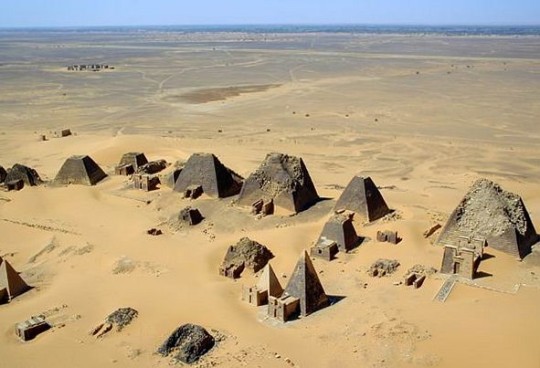
Meroë
Meroe was a wealthy metropolis of the ancient kingdom of Kush in what is today the Republic of Sudan. It was the later capital of the Kingdom of Kush (c. 1069 BCE to c. 350 CE) after the earlier capital of Napata was sacked c. 590 BCE. Prior to that date, Meroe had been an important administrative centre.
The city was located at the crossroads of major trade routes and flourished from c. 750 BCE to 350 CE. Meroe is listed by UNESCO as a World Heritage Site. As no one yet has been able to decipher the Meroitic script, very little can be said for certain on how Meroe grew to become the wondrous city written about by Herodotus circa 430 BCE, but it is known that the city was so famous for its wealth in ancient times that Cambyses II of the Persian Achaemenid Empire mounted an expedition to capture it. The expedition faltered long before reaching the city owing to the difficult and inhospitable terrain of the desert (and, according to some claims, may never have been mounted at all). Still, the persistence of the story of Cambyses' expedition suggests the great fame of Meroe as a wealthy metropolis.
The city was also known as the Island of Meroe as the waters flowing around it made it appear so. It is referenced in the biblical Book of Genesis (10:6) as Aethiopia, a name applied to the region south of Egypt in antiquity meaning "place of the burnt-faces". Although there is evidence of overgrazing and overuse of the land, which caused considerable problems, Meroe thrived until it was sacked by an Aksumite king c. 330 CE and declined steadily afterwards.
Egyptian Influence & King Ergamenes
While there was a settlement at Meroe as early as 890 BCE (the oldest tomb discovered there, that of 'Lord A', dates from that year), the city flourished at its height between c. 750 BCE and 350 CE. The Kingdom of Kush, founded with its capital at Napata, was ruled by Kushites (called "Nubians" by the Egyptians) who, early on, continued Egyptian practices and customs and, though they were depicted in art as distinctly Kushite, called themselves by Egyptian titles. The historian Marc Van De Mieroop writes:
Meroitic culture shows much Egyptian influence, always mixed with local ideas. Many temples housed cults to Egyptian gods like Amun (called Amani) and Isis, but indigenous deities received royal patronage as well. A very prominent Nubian god was the lion-deity Apedemak, a god of war whose popularity increased substantially in this period. Local gods were often associated with Egyptian ones: in Lower Nubia, Mandulis, for example, was considered to be Horus's son. Hybridity is also visible in the arts and in royal ideology. For example, kings of Meroe were represented in monumental images on temples in Egyptian fashion but with local elements, such as garments, crowns, and weapons. (338).
In time, however, these practices gave way to indigenous customs and the Egyptian hieroglyphs were replaced by a new system of writing known as Meroitic. The break from Egyptian culture is explained by the ancient historian Diodorus Siculus who writes that in the time before the reign of King Ergamenes (295-275 BCE), it had been the custom for the high priests of the Egyptian god Amun at Napata to decide who became king and to set the duration of the king's reign.
As the health of the king was tied to the fertility of the land, the priests had the power to determine if the sitting king was no longer fit to rule. If they deemed him unfit, they would send a message to the king, understood to be from the god Amun himself, advising him that the time of his rule on earth was completed and that he must die. The kings had always obeyed the divine orders and had taken their own lives for the supposed good of the people. However, Diodorus continues:
who had received instruction in Greek philosophy, was the first to disdain this command. With the determination worthy of a king he came with an armed force to the forbidden place where the golden temple of the Aithiopians was situated and slaughtered all the priests, abolished this tradition, and instituted practices at his own discretion.
The archaeologist George A. Reisner, who excavated the cities of Meroe and Napata, has famously questioned Diodorus' account calling it "very dubious" and claiming that the Ergamenes story was a national myth which Diodorus accepted as historical truth. Since there is no ancient evidence contradicting Diodorus, however, and since there was clearly a significant cultural break between Meroe and Egypt with Ergamenes' reign, most scholars today accept the account of Diodorus as either certain or something close to actual events.
Continue reading...
175 notes
·
View notes
Text
Statistics of Apollo's Lovers
I was wondering just how unfortunate of a love-life our boy Apollo had, so - as one does - I did the research, math, and writing of said love-life.
such is the life of an adhd teen :)
In total, there are 63 people on this list. I have them separated into eight groups; Immortal, Immortal & Rejected, Lived, Died, Rejected & Died, Rejected & Cursed, Rejected & Lived, and who were Rejected by Apollo
Disclaimer: I am not a historian nor an expert in Greek Mythology, I am just a very invested nerd in Mythology, and in Apollo's mythology in general, and got curious about what his rap sheet actually looks like.
Sidenote: There will be some "lovers" not on this list. Reasons being;
No actual literary sources behind them
Said literary sources are dubious at best
Not enough information is given about the nature of their relationship to make an accurate take
So if somebody isn't on this list, it's because of one of those three reasons. Although there is still a chance I missed somebody! :)
Also, no RRverse lovers include in this list. Sorry my fellow ToA fans.
(Edited 04/05/25 - ALL SECTIONS SOURCED)
Let's begin! :D
Immortal Lovers
Calliope: muse of epic poetry. Mother of Hymenaios and Ialemus (Pindar's 3rd Threnos) by Apollo.
Clio: muse of history
Erato: muse of love poetry
Euterpe: muse of music
Polyhymnia: muse of hymns/sacred poetry
Melpomene: muse of tragedy
Thalia: muse of comedy. Mother of the Corybantes (The Bibliotheca by Pseudo-Apollodorus) by Apollo.
Terpsichore: muse of dance
Urania: muse of astronomy
Boreas: the North Wind. The Boreads called Apollo "beloved of our sire" in Apollonius of Rhodes's Argonautica.
Rhetia: alternate mother of the Corybantes by Apollo. (Strabo's Geography 10.3.21)
11 lovers total here.
10 Female, 1 Male
Immortal & Rejected
Hestia: goddess of the Hearth (Hymn to Aphrodite)
1 Interest. Female.
Lovers Who Lived:
Branchus: mortal shepherd, gifted prophecy (Conon's Narrations 33 & Callimachus's Iambus)
Rhoeo: mortal princess, eventually married an apprentice of Apollo (Diodorus Siculus's Bibliotheca historica 5.62 and Tzetzes on Lycophron 570)
Ourea: demigod daughter of Poseidon, dated Apollo during his punishment with Laomedon; had a son named Ileus, after the city of Troy (Hesiod's Catalogues of Women Fragment 83)
Evadne: nymph daughter of Poseidon, Apollo sent Eileithyia & (in some texts) the Fates to aid in their son's birth (Pindar's Olympian Ode 6)
Thero: great-granddaughter of Heracles, described as "beautiful as moonbeams" (Pausanias's Description of Greece 9)
Cyrene: mortal princess-turned-nymph queen, kick-ass lion wrangler, and mother of two of Apollo's sons - Aristaeus (a god) and Idmon (powerful seer) (Pindar's Pythian Ode 9.6 ff. and Nonnus's Dionysiaca and Callimachus's Hymn to Apollo 85)
Admetus: mortal king, took great care of Apollo during his second punishment, Apollo wingmanned him for Alcestis's hand - basically Apollo doted on him <3 (Callimachus's Hymn II to Apollo and Apollodorus's Bibliotheca 1.9.15 and Hyginus's Fabulae 50–51, and also written about by Ovid and Servius)
Hecuba: queen of Troy, together they had Troilus.
It was foretold that if Troilus lived to adulthood, Troy wouldn't fall - unfortunately, Achilles murdered Troilus in Apollo's temple. When the Achaeans burned Troy down, Apollo rescued Hecuba and brought her to safety in Lycia. (Stesichorus's Fr.108)
Hyrie/Thyrie: mortal. mothered a son by Apollo. Their son, Cycnus, attempted to kill himself after some shenanigans and his mother attempted the same. Apollo turned them into swans to save their lives. (Antoninus Liberalis's Metamorphoses 12 and Ovid's Metamorphoses 7.350)
Dryope: mortal. had a son named Amphissus with Apollo, who was a snake at the time. Later turned into a lotus flower, but it had nothing to do with Apollo so she's still on this list. (noncon; written by Ovid in Metamorphoses 8 CE/AD and later by Antoninus Liberalis in his own Metamorphoses sometime between 100-300 CE/AD)
Creusa: mortal queen. had a son named Ion with Apollo (Euripides's Ion). Please check out @my-name-is-apollo's post for more details because they make some good points about what's considered "rape" in Ancient Greece. I expand on this further at the end of the post.
Melia: Oceanid nymph. Had a son w/h Apollo named Tenerus. (Pausanias's Descriptions of Greece 9.10.5–6)
Melia was said to be kidnapped, and her brother found her with Apollo. He set fire to Apollo's temple in an effort to get her back, but was killed. Melia and Apollo had two kids - but here's the interesting part. Melia was highly worshiped in Thebes, where her brother found her. She was an incredibly important figure in Thebes, especially when connected with Apollo. She and Apollo were essentially the parents of Thebes.
As I read over their story, it sounded like (to me, at least. it's okay if you think otherwise!) that Melia just absconded/eloped with Apollo.
Was kidnapping an equivalent to assault back then? Perhaps. But it's still debated on whenever or not that's true. However, one thing I've noticed reading up on these myths is that when Apollo does do something unsavory, the text says so.
It never says anything about Apollo doing anything to Melia. Her father and brother believe she was kidnapped, but, like mentioned previously, it seems far much more likely that she just ran off with her boyfriend or something.
But that's just my interpretation.
Moving on! :)
Iapis: a favorite lover. Apollo wanted to teach him prophecy, the lyre, ect. but Iapis just wanted to heal :) so Apollo taught him healing :) (Smith 1873, s.v. Iapis)
Aethusa: daughter of Poseidon & the Pleiad Alcyone. Mother of Linus and Eleuther. She is the great-great grandmother of Orpheus. (Apollodorus's Bibliotheca 3.10.1 and Pausanias's Descriptions of Greece 9.20.2 and Suida, s.v. Homer's Of the Origin of Homer and Hesiod and their Contest, Fragment 1.314)
Acacallis: daughter of King Minos. there's a lot of variation on whether or not she had kids with Hermes or Apollo. Some say she had a kid with each. (Stephanus of Byzantium, s.v. Kydōnia (Κυδωνία and Scholia on Apollonius Rhodius, 4.1492)
Chrysothemis: nymph queen who won the oldest contest of the Pythian Games - the singing of a hymn to Apollo. She had three daughters, and one of them is said to be Apollo's. (Pausanias's Descriptions of Greece 10.7.2 and Hyginus's De Astronomica 2.25)
Corycia: naiad. had a son with Apollo. the Corycian Cave north of Delphi is named after her (Hyginus's Fabulae 161)
Leuconoe (also Choine or Philonis): daughter of Eosphorus, god of the planet Venus, and mother of the bard Philammon. (Hyginus's Fabulae 161) She was killed by Diana for her hubris.
Melaena (also Thyia or Kelaino): mother of Delphos, member of prophetic Thriae of Delphi. Priestess of Dionysus. (Herodotus's Histories 7.178.1)
Othreis: mothered Phager by Apollo, and later Meliteus by Zeus. (Antoninus Liberalis's Metamorphoses 13)
Stilbe: mother of Lapithus and Aineus by Apollo. (Diodorus Siculus's Library of History 4.69.1 and Scholia on Apollonius Rhodius, 1.40 and Scholia on Apollonius Rhodius, 1.948)
Syllis (possible same as Hyllis, granddaughter of Heracles): mothered Zeuxippus by Apollo. (Pausanias's Descriptions of Greece 2.6.7)
Amphissa: Apollo seduced her in the form of a shepherd. They had a son named Agreus. (Ovid's Metamorphoses 6.103 and Hyginus's Fabulae 161)
(hey, has anybody else noticed that 'Apollo disguising himself' seems to only be a thing in Roman literature?)
Areia (or Deione): had a son named Miletus. Hid him in some smilax. Her father found him and named him. (Apollodorus's Bibliotheca 3.1.2)
Arsinoe: she and Apollo had a daughter named Eriopis. (Hesiod's Ehoiai 63 and Scholia ad Pindar's Pythian Ode 3.14)
Queen of Orkhomenos (no name is given): Mother of Trophonius (Pausanias's Descriptions of Greece 9.37.5)
(my fellow ToA fans will recognize that name haha).
Hypermnestra: Either Apollo or her husband fathered her son Amphiaraus. (Hyginus's Fabulae 70)
(sidenote: @literallyjusttoa suggested that Apollo was dating both Hypermnestra and Oikles, and I, personally, like that headcannon)
Manto: Daughter of Tiresias. Apollo made her a priestess of Delphi. They had a son named Mopsus. When Apollo sent her to found an oracle elsewhere, he told her to marry the first man she saw outside of Delphi. That man turned out to be Rhacius, who brought her to Claros, where she founded the oracle of Apollo Clarios. (Apollodorus's Bibliotheca E6. 3)
Later, another man named Lampus attempted to assault her, but was killed by Apollo. She is also said to be a priestess who warned Niobe not to insult Leto, and to ask for forgiveness. Niobe did not. (Statius's Thebaid 7 and Ovid's Metamorphoses 6)
(Dante's Inferno places her in the eighth circle of hell, and let me just say- what the FUCK Dante! What did Manto ever do to you, huh??!! Don't do my girl dirty!!)
Parthenope: granddaughter of a river god. Mothered Lycomedes by Apollo (Pausanius's Descriptions of Greece 4.1)
Phthia: prophetess. called "beloved of Apollo". Mother three kings by him; Dorus, Laodocus, & Polypoetes (Apollodorus's Bibliotheca 1.7.6)
Procleia: Mother of Tenes, son of Apollo, who was killed by Achilles before the Trojan War. Daughter of King Laomedon, king of Troy. (Apollodorus's Epitome 3. 26)
Helenus: prince of Troy. Received from Apollo an ivory bow which he used to wound Achilles in the hand. (Photius's 'Bibliotheca excerpts')
Hippolytus of Sicyon: called "beloved of Apollo" in Plutarch's Life of Numa. I don't think this guy is the same as Hippolytus, son of Zeuxippus (son of Apollo), king of Sicyon Pausanias talks about in his Description of Greece. That would be a little weird taking the whole family tree into account - though it's never stopped other gods before. *shrug*
Psamathe: nereid, said to be the personification of the sand of the sea-shore. (Conon's Narrationes 19)
She and Apollo were lovers, but never had any kids. When another man assaulted her, she had a son and abandoned him.
(He was found by some shepherds dw - wait, he was then torn apart by dogs. Nevermind.)
Back to her, her father ordered for her to be executed and Apollo avenged her death by sending a plague onto Argos and refused to stop it until Psamathe and Phocus/Linus (her son) were properly given honors.
(I really like how even though Linus isn't Apollo's kid, and that Psamathe wanted nothing to do with the kid, Apollo still considered him worth avenging too <3 )
Okay, in a previous incarnation of this post, I said there was a version where she is raped by Apollo...however, I can't find any sources to back it up😅 Even her wiki page doesn't mention rape, and Theoi's excerpt of Paunasias's Descriptions of Greece about her doesn't either.
So where did I hear about this supposed version? (Don't shoot)
Youtube. A youtube video about Apollo. Yeah...
Lesson, kids! Don't trust youtube videos on mythology! Yes, even if they dedicated lots of time to it! They can still get things wrong! In fact, don't even take my word for it! Do your own research <3
Hymenaeus: No, not his kid. This is a different Hymenaeus haha! This Hymenaeus is the son of Magnes, and comes from Megalai Ehoiai fr. 16, commonly attributed to Hesiod, and Antonius Liberalis's Metamorphosis. Legend states that while Apollo was preoccupied with Hymenaeus, baby Hermes stole his cows ;)
Euboia: Daughter of Macareus. Bore a son named Agreus. (Hyginus's Fabulae 161)
Philodice: Wife of Leukippos, mothered Phoebe and Hilaera by Apollo (Descriptions of Greece 3.16.1, citing the Kypria).
Alright. 37 lovers here.
6 Male. 31 Female.
35 are 100% consensual. Creusa is questionable, depending on who's translating/which tradition you go with. Dryope is noncon.
Lovers Who Died:
Hyacinthus*: mortal prince. we all know this one, right? Right? one and only true love turned into flower (okay that's my bias speaking but AM I WRONG?) (Plutarch's Life of Numa, 4.5; Philostratus the younger's Imagines; Pseudo-Apollodorus's Bibliotheca 1.3.3; Ovid's Metamorphoses 10.162–219; Bion's Poems 11; and various pieces of art)
Cyparissus: mortal. his DEER DIED and he asked Apollo to let him MOURN FOREVER so he was turned into a cypress tree (Ovid's Metamorphoses X 106ff)
Coronis: mortal princess. cheated on Apollo w/h Ischys, who in Fabulae was killed by Zeus. mother of Asclepius. killed by Artemis. (Pindar's Pythian Odes 3.5; Pausanias's Descriptions of Greece 2.26.6; Hyginus's Fabulae 202; Ovid's Metamorphoses 2.536 and 2.596; Hyginus's De Astronomica 2.40; Isyllus's Hymn to Asclepius 128.37 ff.)
There is another version of Asclepius's birth given by Pausanias in Descriptions of Greece 2.26.1-7, where Coronis exposes him on a mountain and Apollo takes him in.
Adonis: yes, THAT Adonis. he's in this category because. well. he died. rip (Ptolemy Hephaestion's New History Book 5)
Phorbas: Okay so Apollo's lover Phorbas and another Phorbas sometimes get mashed together so this is what I was able to gather.
Plutarch's Life of Numa 4.5 and Hyginus's De Astronomia 2.14.5 cites Phorbas as Apollo's lover. The other Phorbas is said to be a rival to Apollo in the Homeric Hymn to Apollo. Personally, I separate the two because it makes more sense with Phorbas the lover's overall story.
Here it is: The island of Rhodes fell victim to a plague of dragons or serpents, and the oracle said to summon Phorbas for help. He defeated the infestation, and after he died, Apollo asked Zeus to place him in the stars, and so Phorbas became the constellation Serpentarius, also known more widely as Ophiuchus (a man holding a serpent).
FORGET ORION AND HIS ONE-OFF MENTION OF BEING DIANA'S LOVER HERE IS A CONSTELLATION TRAGIC LOVE STORY!!!!!
(*Hyacinthus was resurrected, as celebrated in the Hyacinthia festival in Sparta. Nonnus's Dionysiaca 19.102 and Pausanias's Descriptions of Greece 3.19.4 supports this belief as well.)
5 lovers.
4 Male. 1 Female. All consensual.
Sidenote: QUIT BURYING THE GAYS GREECE!!!!
Love-Interests Who Rejected & Died:
Daphne: do i nEED to say anything? Nymph. turned into tree to escape.
Daphne and Apollo actually go back a bit. Their story was used to explain why the laurel was so sacred to Apollo. It's in Delphi, Branchus planted laurel trees around the temple he built to Apollo, the laurel was even sacred to Apollo's historical forebearer Apulu, an Etruscan god! (I have sources to back this up :3 along with an Essay.)
Apollo & Daphne first originate from Phylarchus, but we do not have any of his work :( It's been lost to history...a moment of silence RIP. He was a contemporary in the 3rd century BC/BCE (first day of 300 BC/BCE and last day of 201 BC/BCE).
He was, however, cited as a source in Parthenius's Erotica Pathemata, written sometime in the 1 century AD/CE (sometime between 66 BC/BCE and the author's death in 14 AD/CE).
Then they show up again in Pausanias's Descriptions of Greece, written between 150 AD/CE and 170 AD/CE.
Hyginus wrote his Fabulae sometime before Ovid's because it's widely criticized to be his earliest work and Ovid wrote his Metamorphoses in 8 AD/CE.
The first two versions are roughly the same, and Ovid's shares similarities with the first in only the ending. Hyginus is basically like Ovid's but without Eros.
So in publication order, it's; Erotica Pathemata, Fabulae, Metamorphoses, then Descrip. of Greece.
In Erotica Pathemata, Daphne is the daughter of Amyclas and is being courted by Leucippus. She is not interested in any sort of romance. Leucippus disguises himself as a girl to get close to her, but his ruse is revealed when Apollo nudges Daphne and her attendants into taking a bath in the river. Leucippus is consequently killed.
Apollo then becomes interested and Daphne runs away, imploring Zeus that "she might be translated away from mortal sight", and is transformed into the laurel tree.
In Fabulae, Daphne's story is a bit more familiar. She's the daughter of Peneus, the river god, and Gaea is the one who transforms her into a laurel tree.
In Metamorphoses, Eros is added to the story and is the reason why Apollo is so enamored and Daphne is so repulsed.
(I would just like to say that in this version, it was 100% nonconsensual for both of them! And I don't mean with rape- Apollo never touches Daphne in any of these version. What I mean here is that Eros maliciously makes Apollo chase down a woman and makes sure Daphne would be repulsed by him. That is noncon behavior there on both sides.)
In Descriptions of Greece 10.7.8, Daphne is the daughter of Ladon and her and Apollo are only connected by way of why the laurel crown is the victory prize of the Pythian Games. However, in Descriptions of Greece 8.20.2-8.20.4, Daphne and Leucippus make an appearance here too, but Apollo is not the reason why they stop to take a swim and his ruse is revealed, resulting in his death.
Castalia: Nymph. turned into spring to escape.
First things first, Castalia was used to explain the existence of the Castalian Spring in Delphi. However, in the Homeric Hymn to Apollo, the spring is already there when Apollo was born. So there's that to consider first.
Anyway, to escape Apollo's advances, Castalia transforms herself into a spring. (Lactantius Placidus's On Statius's Thebaid 1.698. This was written between Lactantius's lifespan of c. 350 – c. 400 AD/CE, placing it firmly in Roman times.)
2 Interests.
2 Female.
Love-Interests Who Rejected & Cursed
Cassandra: mortal princess. Received the gift of prophecy from Apollo. Due to a broken oath, she was then cursed. (Aeschylus's Agamemnon)
It is only in Roman-era tellings where Cassandra is cursed for not sleeping with Apollo, and there was no oath made (Hyginus & Pseudo-Apollodorus). In Agamemnon, it was done so because of the broken oath- not the refusing to sleep with Apollo thing.
The version where she gains prophetic abilities by way of a snake licking her ears is not part of Greco-Roman literature, but rather by an American poet.
Nevertheless, even after the curse Cassandra still loved Apollo, and called him "god most dear to me" in Eurpides's play The Trojan Women.
1 Interests.
1 Female.
Love-Interests Who Rejected & Lived
Sinope: mortal. there are two different version of her myth.
In Diodorus Siculus's Library of History 4.72.2 and Corinna's Frag. 654, Apollo "seizes" her and they have a son named Syrus.
In Apollonius's Argonautica 2.946-951 and Valerius Flaccus's Argonautica 5.109, it is Zeus who abducts her, but she gets him to promise her anything and requests to remain a virgin. He obliges. Later, Apollo and the river Halys both try to charm her, but fall for the same trick.
Library of History was written between 60-30 BC/BCE, Apollonius's Argonautica between 300 BC/BCE and 201 BC/BCE, and Valerius Flaccus's Argonautica between 70-96 AD/CE, making Apollonius's version the oldest and Valerius Flaccus's the youngest.
Marpessa: mortal princess, granddaughter of Ares. Idas, son of Poseidon, kidnapped her and Apollo caught up to them. Zeus had Marpessa chose between them, and she chose Idas, reasoning that she would eventually grow old and Apollo would tire of her. (Homer's The Iliad, 9.557 and Apollodorus's Bibliotheca 1.7.8–9)
Bolina: mortal. Apollo approached her and she flung herself off a cliff. He turned her into a nymph to save her life. (Pausanias's Description of Greece 7.23.4)
Ocroe/Okyrrhoe: nymph and daughter of a river god. asked a boatman to take her home after Apollo approached her. Apollo ended up turning the boat to stone and the seafarer into a fish. (Athenaeus's The Deipnosophists 7.283 E [citing The Founding of Naucratis by Apollonius Rhodius]. The Deipnosophists was written in the early 3rd century AD, between 201 AD and 300 AD)
Sibyl of Cumae: mortal seer. promised to date Apollo if she was given longevity as long as the amount of sand in her hand. he did, but she refused him. (Ovid's Metamorphoses 14)
5 Interests. All female.
Okyrrhoe's story is the only one with any iffy stuff, although, when something iffy does occur, the text usually says so outright.
Rejected by Apollo:
Clytie*: Oceanid nymph. turned into a heliotrope to gaze at the sun forever after the rejection.
1 Advance. Female.
(*Clytie's story was originally about her affection for Helios. [Ovid's Metamorphoses 4.192–270; Ovid used Greek sources about the etymology of the names involved, meaning Clytie and Helios go back to Greek times] As Apollo got superimposed over Helios's myths, people have assumed it is he who is the sun god in her myth and not Helios.)
In Conclusion...
63 people total, and 35 of them have Roman-Era roots with (as far as I know!! Don't take my word as gospel truth!!) no relation to Greece except by way of shared mythology.
Here's the list:
Rhoeo
Thero
Hyrie/Thyrie
Dryope
Melia
Aethusa
Acacallis
Chrysothemis
Corycia
Choine
Thyia
Othreis
Stilbe
Syllis
Amphissa
Areia
Queen of Orkhomenos
Hypermnestra
Manto
Parthenope
Phthia
Procleia
Helenus
Hippolytus of Sicyon
Psamathe
Cyparissus
Adonis
Phorbas
Castalia
Sinope
Bolina
Ocroe/Okyrrhoe
Sibyl of Cumae
Rhetia
Euboia
Meaning, 56% of the lovers listed on this post are not entirely Greek in origin (AS FAR AS I KNOW-)! That does not mean ofc that you have to ignore them. I, for one, really like the story of Rhoeo, and Manto, and Psamethe- I find their myths sweet (Rhoeo & Manto) and bittersweet (Psamethe).
Let's get to the calculations now, yeah?
63 people total (Includes Clytie)
51 Women (81%). 12 Men (19%).
19% were Immortal (Including Lovers & Rejected)
74% Lived (Including Lovers & Cursed & Rejected)
11% Died (Including Lovers & Rejected)
2% were Cursed
2% were Rejected by him
62 people total (Not Including Clytie)
50 Women (81%). 12 Men (19%).
19% were Immortal
69% Lived (Lovers & Cursed & Rejected)
11% Died (Lovers & Rejected)
in that 11%, one was apotheosized - Hyacinthus.
Meaning 9% died permanently, while 2% were resurrected.
2% were Cursed
0% were Rejected by him
Additionally, I left off five male lovers and two female lovers - Atymnius, Leucates, Cinyras, Erginus, Leukippos, Hecate, & Acantha.
Atymnius has no references to being Apollo's lover, only to Zeus's son Sarpedon. (Wikipedia why do you even have him listed? You need sources smh)
Leucates is another male "lover" left off the rack - apparently he jumped off a cliff to avoid Apollo, but I couldn't find any mythological text to account for it- and no, OSP's wiki page is not a reliable source. There is a cliff named similarly to him where Aphrodite went (by Apollo's advice) to rid herself of her longing for Adonis after his death. Also Zeus uses it to rid himself of his love for Hera before he...well, commits adultery again. 🤷
Cinyras was a priest of Aphrodite on the island of Cyprus. He was also the island's king. Pindar calls him "beloved of Apollo" in his Pythian Ode. However, looking further into Cinyras's life throws a bit of a wrench into it. He's also cited to be a challenger to Apollo's skill, and either Apollo or Mars (Ares) kills him for his hubris.
(honestly, I kinda like the idea that Mars went into Big Brother Mode)
I did consider leaving him on the list, since technically you could argue it was a romance-gone-bad, but among every other source Cinyras is mentioned in, Pindar's the only one who puts a romantic label on him and Apollo.
Plus, he’s been described as a son of Apollo too, and I personally like that more lol
Erginus now I only put on here because I saw a tumblr post saying he was a lover of Apollo, but after consulting fellow nerds on the matter we concluded that there is (very likely) no records indicating such. Hence his placement here to curb potential misinformation <3
Leukippos is here for much the same reasons as Erginus. Full disclosure here from fellow nerds but long story short a few of his daughters are said to be Apollo’s by way of his wife, who is on this list (Philodice in the Lived section!)
Hecate, the goddess of magic and crossroads, is said to be the mother of Scylla (like, the sea-monster) by Apollo, but Scylla's parentage is one of those "no specific parents" ones, so I left her off the list.
Acantha has absolutely no classical references. There's a plant like her name, but she's made-up, so she doesn't count. *stink-eyes the guy who invented her and claimed his “sources” were reliable when they really aren’t*
(Of course, I could be wrong about any of these. Again, I'm not an expert.)
With all this in mind, this means Apollo's love life actually isn't as tragic as media portrays it, and he isn't as bad as Zeus or Poseidon in the nonconsensual area.
Does he still have those kinds of myths? Yes, with Dryope and Creusa; though, we can discount Creusa because;
1) Depends on who's translating it; and
2) Ion is given different parentage in the Bibliotheca, which yes, came much after Ion, however Xuthus was traditionally considered to be Ion's father rather than Apollo. This means there was probably a different oral tradition on Ion's parentage that just wasn't written down as early as Euripides's was- in fact, it may even just be an invention of Euripides's.
(and honestly Apollo's characterization in Ion just doesn't quite match up with the rest of his appearances in the wider myths (in my opinion, at least))
So that leaves us with just Dryope, who comes from Ovid, a Roman poet, and Antoninus Liberalis, a late Greek one.
Now I'm not saying we should throw her out because of Ovid's whole "wrote the gods even more terribly to criticize Augustus" thing, but it is something to keep in mind. Political mechanics have been used to change myths before, and this is certainly one example of it.
Additionally, I have seen many people discard Dionysus's rapes in the Dionysiaca because of how late it was written, so this one can be given similar treatment if one choses too because of just how late Ovid and Antoninus Liberalis's work was.
You can, in fact, pick and chose if you wish, especially if it'll increase your enjoyment of literature. That's certainly what I do :)
So overall, I'd say Apollo has a rather clean relationship past. He's doing pretty damn good.
Also, I think we should all take note that even if Apollo had noncon myths, that doesn't reflect on the actual god. The Ancient Greeks did not see the myths as "canon" to their gods- in fact, some were not happy with the myths showing the gods in such a light.
That's something else to keep in mind. The gods of the myths are not the gods of Greece, and are more like parables or fables for the Ancient Greeks I'd say. Lessons on morality and such, and of course, warnings against hubris and the like.
This was quite the journey, and I really hope you all enjoyed reading and learning with me! This really makes me wonder- if Apollo's love life is this good, I wonder how misinformed we are on everyone else's? I have no plans on doing Zeus or Poseidon or anyone else (not for a LONG time lol, this took a lot of effort and research!), but if anyone has any idea, or gets inspired to do something like this for any other god, please tag me!! I'd love to see it! :D
And since this was on a previous reblog, here be a meme from a while ago:

[ID: Me Explaining Me. On the left is a girl with her hands up, fingers pinched together, like she's intensely explaining something. The text over her says "Me giving a detailed diatribe about Apollo's love life and how modern media has done him and his lovers dirty". On the right is the girl's mother, wrapped up to her chin in a blanket, with a look on her face that screams "absolutely done with this shit". The Mother is labeled "My family". /End ID]
suffers in I'm the only mythology nerd in the family
#ramblings of an oracle#greek mythology analysis#apollo#greek myths#greek gods#greek myth#ancient greece#still gonna tag this as toa#just because#;)#the trials of apollo#toa#trials of apollo#tagamemnon#greek history#ancient greek#greek mythology#greek tumblr#ancient rome#ancient history#rome#greece#apollon#apollo deity#hyacinthus#hyacinth#apollo x hyacinthus#apollo and hyacinthus#cassandra of troy#the muses
1K notes
·
View notes
Text
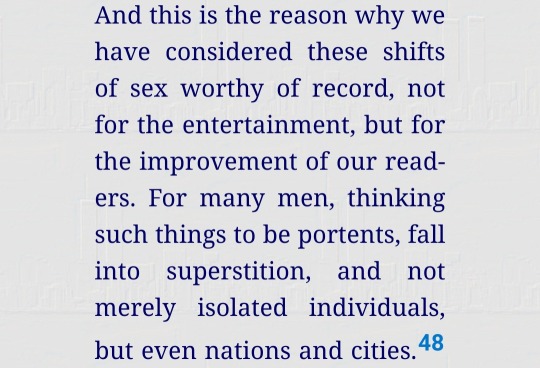
ive fallen into a bit of a rabbit hole of reading about the stories of ancient intersex people transitioning socially from one gender to the other as depicted in diodorus siculus's writing and i was just. so thrilled by the way he describes his reasoning for telling these stories- not for entertainment, but the widen his readers' perspectives
like yes he's still an ancient author and some of the ways he talks about the topic arent up to par with modern understanding, but...it gives you a sense of hope and connection to the humanity that has always existed in us
#these are some incredible stories btw#tagamemnon#queueusque tandem abutere catilina patientia nostra
781 notes
·
View notes